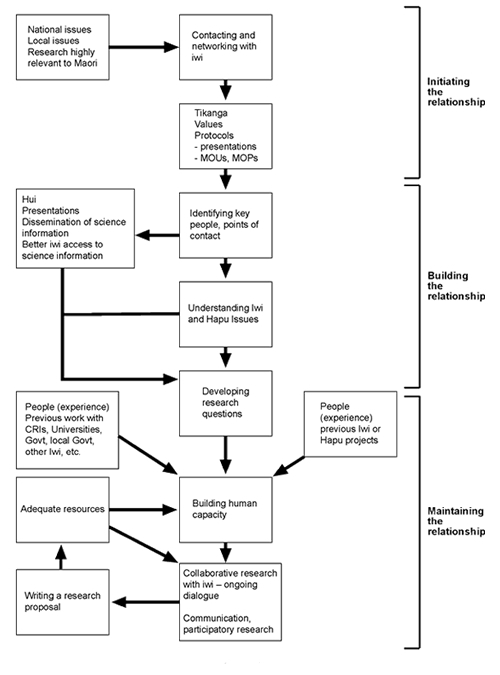Successful ingredients for developing relationships with iwi and hapu

Weaving flax. Image Adrienne Farr
A number of key steps or "ingredients" form the basic building blocks of effective collaborative research with iwi. These have been drawn from the Ngati Porou case study outlined in section 2, and from experience working with iwi over the last 10 years, and can be used as guidelines in developing relationships or partnerships with iwi to set up collaboration (Figure 1).
Initiating, building and maintaining a relationship with iwi
The most apparent ingredient is to build a meaningful relationship from the start. It is recommended that groups or individuals working with iwi have empathy towards Mäori culture and have a cultural standard that makes them aware of cultural protocol and sensitivities. All possibilities of developing a relationship or partnership with iwi can be destroyed by not following protocols or the right procedures, by not understanding tikanga Mäori, Mäori concerns and issues, or by not talking to the right people from the start. It is therefore important to:
- identify immediately the right iwi organisation with whom to work. In some geographic areas this may involve talking to a wide range of iwi members, groups, and Mäori organisations before narrowing down work with one group. It may involve talking to several iwi rather than just one. It is important at this point to have some understanding of whakapapa, Mäori values, and to enter discussions with an open mind. For a scientist or researcher it is important to realise that this stage is at the bottom of learning curve;
- identify key people to work with in the iwi or Mäori organisation. Many of these may be working at the 'coal-face' rather than at the top of the organisation;
- be aware of cultural or political protocols, and have some understanding of inter-iwi and intra-iwi politics and relationships;
- have some understanding of, or identify, Mäori issues, either within a geographic area or nationally;
- take a personal interest, much wider than the research interest, in the iwi, Mäori organisation, or the iwi personnel being approached;
- set up and maintain regular contact and dialogue so the relationship may progress;
- maintain the relationship by regular networking and communication, personal visits, and regular contact (e.g., E-mail, phone, letter);
- identify a common area of interest, e.g., an issue(s), or interesting research on which to focus;
- be willing to help iwi or individual iwi members, even before setting up collaborative projects, to access and disseminate information of particular interest, networking with other researchers, or other iwi, helping with iwi proposals for funding, etc.;
- demonstrate some long-term commitment to wanting to work with the iwi.
Importance of protocols and tikanga in developing relationships
In terms of protocols it may be necessary to visit iwi representatives, at the highest organisational level, when beginning a relationship, and giving an initial presentation to a Runanga, Trust Board, Incorporated Society, council, committee, or staying on a marae. In many situations, this stage is a formal process when starting work with any iwi, before any collaboration or participation. Presentations will involve mihi, and an essential part of any presentation will be to let people of a Mäori organisation, especially senior members, know who you are - your identity, your whakapapa, what you are doing or intend to do, what your research interest is, who you would like to work with,
how you intend to work with iwi, hapu, or other groups. It will generally follow tikanga, protocols and
kawa set down by the iwi with whom you intend to work. It is often at this stage that the type and
content of a memorandum of understanding or partnership (i.e. MOU or MOP) should be considered. Manaaki Whenua has developed both MOUs and technical service MOUs at the beginning of most projects. In many cases a MOU/MOP will formalise the relationship between, for example, a CRI or University, and an iwi in terms of protocols, kawa, and assurance of the involvement of the right people. This sets the scene for follow-up hui, more informal discussion, networking, and initiating projects.
Presentations may be repeated at several hierarchical levels in an iwi to different audiences, down to the marae and individual level, or to a specific iwi group, and usually take place at different locations.
Understanding and characterising Mäori issues
To understand iwi/hapu Mäori issues and link these to potential research, more informal discussions often follow with a number of groups and individuals. To build a collaborative model it is important to listen carefully to iwi and individuals and to synthesise information without misinterpretation. It is also important to demonstrate a willingness to help and learn. Issues will be much wider than just research issues, and will involve understanding economic, cultural, political, environmental, social, and historical issues. It is often useful to discuss iwi issues in a suitable environment where these issues have meaning, such as in the field, on a marae, or at an iwi or hapu designated office. Issues need to be characterised and carefully defined from a Mäori and scientific perspective. It is recommended at this stage that reciprocal visits be made between an iwi/hapu and other organisations intending to work with iwi. It is important from a Mäori point of view to 'see' and 'feel' the work place of, and be hosted by, potential collaborators. Key Mäori or iwi issues should then be documented. Issues should be discussed through formal or informal communication, such as a letter or E-mail, and agreed upon, in terms of what had been discussed previously at hui or in the field.
In establishing relationships with iwi for collaborative research, much discussion will be on issues, the research questions needed to address those issues and the capabilities (skills and expertise) needed to carry out the work.
 |
| Figure 1: The key steps to developing collaborative research with iwi |
